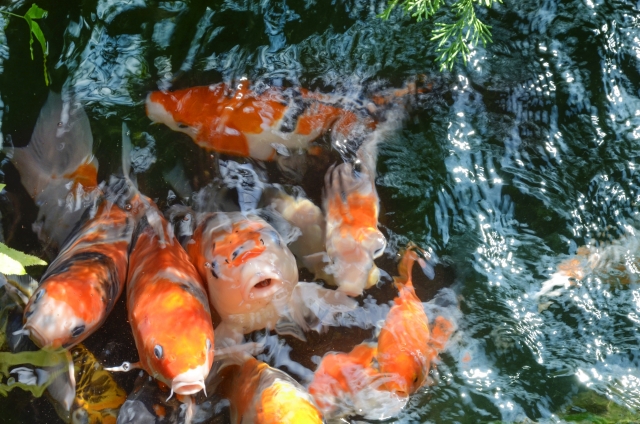Seeking for glimpses of aristocrats in Heiana era (from late 8th century to late 12th century), I visited mountain area of Kyoto; Arashiyama and Sagano. From downtown Kyoto, I took a subway and a tram. The tram went through residential area and the landscape gradually got peace and quiet. And while going up the foot of Arashiyama mountain, traveler’s sentiment got filled up.
平安貴族の面影を追って、京都は嵐山嵯峨野を訪れた。京都市街地から地下鉄と嵐山電鉄に乗り継いで行く。路面電車が民家の間を通り抜け、だんだん風景が静かに落ち着いたものになってくる。嵐山の方へいよいよ登って行くと、旅情が一段と高まってくる。
But at the final destination of Arashiyama station, I noticed the atmosphere was nothing but a busy tourist site. I was slightly disappointed since it was just like all other tourist landmarks around the world.
しかし、終点の嵐山駅に着いてみればそこは観光化され、多くの人で賑わっていて、少しがっかりする。世界中の観光地と一つも変わらないな、と。
Unconsciously, I was looking for a little melancholic and poetic atmosphere. I was looking for something a little sad and touching, maybe expecting lonesome feelings. Wondered if anyone who comes to Arashiyama and Sagano seeking for the world of the court literature feel the same. Even though, by stepping in further I was able to find glimpses of the ancient times here and there. Certainly, the place where many of classical literature masterpieces were written is sheerly a treasure of Japan.
風光明媚で閑散とした、少し物悲しい情緒を知らずのうちに求めていたのだ。源氏物語や百人一首や枕草子の王朝文学の世界を求め、嵐山嵯峨野にやってくる人は皆、こうやって勝手にがっかりするのかも知れない。しかしそれでも、一歩奥へと足を踏み入れると、やはり平安時代の面影はそこかしこに残っている様で、日本の古典文学の傑作が多く書かれた場所というこの地は、誠に日本の至宝であることに変わりはない。

Walked along Ohi river where Heian era aristocrats enjoyed riding on a boat. The shade of greenery was so soothing. In 926 Emeritus Udain, father of Emperor Daigo had a sightseeing cruise. The colored maple leaves of Ogura mountain were stunning. His majesty wished to show the sight to his honored son. That time, one of the vassals Fujiwarano Tadahira promptly made a poem, as if calling to the maple leaves in front of them.
平安貴族が川遊びをした大堰川の脇を歩く。緑陰が涼しい。926年(延長4年)に宇多院が臣下を連れて大堰川を遊覧されたところ、小倉山の紅葉があまりにも見事だったので、「我が子醍醐天皇にもぜひ見せたい」と願った。すると随行していた藤原忠平が即妙に、眼前の紅葉に呼びかける様にしてこの歌を詠んだとのこと。
Ogura mountain
Colored maple leaves of the peak
If you have a heart
Wait until the Emperor to come
Just one more time
小倉山
峰のもみじ葉
心あらば
今ひとたびの
みゆき待たなむ
小倉山の峰のもみじよ
もしお前にこころがあるならば
もう一度天皇の行幸があるので
それまで散らずに待っていてほしい
From Hyakunin Isshu; classical Japanese anthology of one hundred waka poems by one hundred poets compiled in around 1235.
1235年ごろに編纂された小倉百人一首より



When going along the river, there was nobody around. I was absorbed in sentiment in the tranquility and thinking about noble people playing in the water in Heian era more than 1,000 years ago. Water, greenery, light, and shade are mingled together and it induces the Japanese beauty.
川を遡って行くと周りに誰もいなくなり、一人静かな情緒に浸りつつ、一千年以上も前にここで川遊びをしていた、平安朝のやんごとなき方々のことを思う。水と緑と光と陰は、それらが絡まり合って日本的な美が醸し出されて行く。
For about an hour I was walking, then went back to the station area. School excursion junior high or high school kids, not only girls but boys and even teachers were also wearing summer kimono and walking around. So adorable. In historical places like Kyoto or Asakusa, people love the new trend of wearing kimono or summer kimono and enjoy sightseeing. Each one of us enjoy the history richly with our own style.
一時間ほど歩いて、駅前へ戻る。修学旅行の中学生か高校生だろうか、女子も男子もそして引率の先生も浴衣を着て歩いていて、とても可愛い。京都や浅草など、日本的な情緒のある街を着物姿や夏は浴衣姿で歩くという、比較的新しい観光地における流行は、大変な人気である。それぞれがそれぞれの形で歴史を感じながら、豊かな時間を味わっているのだ。


Then I visited Tenryuji Temple that is UNESCO world heritage site. Lotus leaves welcomed me. I could see some flowers as well. This temple was established in 1339 by Ashikaga Takauji in order to enshrine and dedicate condolence to the spirit of Emperor Godaigo.
ユネスコ世界遺産の天龍寺へ。放生池の蓮の葉が出迎えてくれた。ちらほらと蓮の花も咲いている。天龍寺は臨済宗天龍寺派の大本山であり、1339年(暦応2年)に足利尊氏が後醍醐天皇の菩提を弔うために創建したお寺さんだ。

Daruma picture.
達磨図も見応えあり。

This magnificent Sougenchi pond garden with the surrounding scenery of Arashiyama mountain and Kameyama mountain is the first garden of Japan designated as Special Place of Scenic Beauty. Sat on tatami mat and wooden hall way, I was appreciating the view for a while. It was relaxing and peaceful time all alone.
嵐山や亀山を借景とした雄大な曹源池庭園は、国の史跡・特別名勝の指定第一号としても有名とのこと。座敷の畳や廊下の板張りに腰掛けて、しばしお庭を鑑賞する。そこには、ゆっくりとした長閑な時間が流れていた。



Walking in the Tenryuji temple building was so classy, the aroma of old woods was so chic. After spending some time inside, walked in the garden next. Hydrangeas were blooming gracefully. It is the symbol of rainy season in Japan. Reminded me of a lovely sight when in kindergarten, grandmother cut hydrangeas in the garden and she let me bring them to the kindergarten saying “Ask your teacher to decorate in the classroom.”
天龍寺の建物の中を歩くのも、古木の香りが芳しく乙なものだった。しばし時を過ごしたのち、庭園を歩く。紫陽花が誇らしげに咲いている。紫陽花は、日本の梅雨の風物詩。幼稚園の頃に庭の紫陽花を手折って「先生に言って教室に飾ってもらいなさい」と持たせてくれた、祖母のことを思い出す。


Tenryuji Temple garden was leading to a bamboo path.
天龍寺の庭を出ると竹林の道へと繋がっていた。


This soothing and refreshing atmosphere surrounded by the greenery is perfect for writing with peace and quiet. Poet Fujiwarano Teika compiled Hyakunin Isshu anthology, one hundred poems by one hundred poets in a mountain cottage under the foot of Ogura mountain. And Lady Murasaki chose Nonomiya as a sad parting stage in The Tale of Genji. Thinking of those splendid literary works were born here, I could sense as if the spirits of the Heian era aristocrat writers who treasured love, elegance, and sentiment more than anything were still hiding in the bamboo forest.
緑に包まれた心地よい清々しさと静かな佇まいは、心を落ち着けて文筆をするには確かにふさわしい場所だと頷ける。歌人・藤原定家が小倉山の麓の山荘で小倉百人一首を編纂し、紫式部が源氏物語の第十帖賢木の巻の舞台に野宮を描きその悲恋の舞台にしたこと、この地は王朝文学ゆかりの地であることを考えると、恋や風雅や情趣が何にもまして大切であった平安貴族たちの雅なる精神が、この竹林の陰から見えてくる様な気持ちになる。
*Read for my blog article of Hyakunin Isshu poem anthology.
百人一首に関しての記事を書いているので、是非ご一読ください。
↓↓↓
Ancient Love Hyakunin Isshu
*Read for my blog article of The Tale of Genji.
源氏物語に関しての記事も書いているので、こちらもどうぞお読みください。
↓↓↓
Love Affairs in The Tale of Genji
This Nonomiya Shrine is written in The Tale of Genji. Hikaru Genji and Rokujono Miyasunndokoro spent an unforgettable night together and experienced a parting the following day, the shrine is famous for good matching.
こちらの野宮神社は源氏物語ゆかりの古社である。光源氏と六条御息所が離れがたい一夜を過ごして、そして別れて行ったとされるところで、良縁祈願の神社として名高い。

Many kinds of good luck charm for good matching were sold.
縁結びのお守りが多く売られていた。



Needless to say, good matching is the crucial matter for all girls. Heian era aristocrats and we 1,200 years later, what we all wish for hasn’t changed at all. I was walking around Arashiyama and Sagano in Kyoto, the special sentiment was there.
すべての乙女にとって、良縁に恵まれることよりも大切なことなどありはしない。平安貴族も、それから千二百年後の私たちも、きっと考え願い続けることは何一つ変わらないのだと、しみじみと思った京の嵐山嵯峨野散策のひと時だった。
Love and Peace…
参考文献
「百人一首解剖図鑑」谷知子、株式会社エクスナレッジ、2020
「ココミル京都関西①」田村知子編、JTBパブリッシング、2020
「ニッポンを解剖する!京都図鑑」竹市理加子編、JTBパブリッシング、2016






















